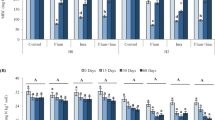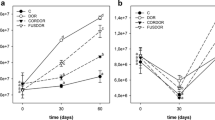Abstract
Ferulic acid (4-hydroxy-3-methoxycinnamic acid) is found in both plants and soils, and some evidence suggests its involvement in biochemical interactions between plants (allelopathy) and other organisms living in the soil. Knowledge of the processes affecting the concentrations of such potential allelochemicals in soil is essential if we are to understand their roles in the soil environment. It was the intent of this study to address the effects that soil physicochemical and biological processes have on the recovery of exogenously applied ferulic acid from tropical forest soils. Soil extractants used in this study are thought to recover potentially bioavailable concentrations of applied ferulic acid. Water and sodium acetate extractions of soil (immediately and after one and two days) were employed in the recovery of ferulic acid (added at a rate of 5.15 mmoles kg−1) from steam-sterilized and non-sterilized forest soil materials. Sterilization of soil was used to isolate physicochemical effects from microbial effects on ferulic acid. Results indicate some sterilization treatment effects on the immediate recovery of ferulic acid. Physicochemical and biological processes of soils decreased the recovery of ferulic acid. The immediate recovery of ferulic acid from non-sterile soils is inversely related to the % organic carbon present in the soils. Certain soils have the ability to ‘trap’ ferulic acid molecules for subsequent release into the soil-solution phase. Furthermore, results suggest that microbial degradation of ferulic acid may only occur in the solution (bulk) phase; ferulic acid molecules thought to be bound to soil surfaces appear to be protected from degradation.
Similar content being viewed by others
References
Blum U and Dalton BR 1985 Effects of ferulic acid, an allelopathic compound, on leaf expansion of cucumber seedlings grown in nutrient culture. J. Chem. Ecol. 11, 279–301.
Blum U, Dalton BR and Rawlings JO 1984 Effects of ferulic acid and some of its microbial products on radicle growth of cucumber. J. Chem. Ecol. 10, 1169–1191.
Blum U, Dalton BR and Shann JR 1985a Effects of various mixtures of ferulic acid and some of its microbiol metabolic products on cucumber leaf expansion and dry matter in nutrient culture. J. Chem. Ecol. 11, 619–641.
Blum U, Dalton BR and Shann JR 1985b The effects of ferulic and p-coumaric acids in nutrient culture on cucumber leaf expansion as influenced by pH. J. Chem. Ecol. 11, 1567–1582.
Blum U, Weed SB and Dalton BR 1987 Influence of various soil factors on the effects of ferulic acid on leaf expansion of cucumber seedlings. Plant and Soil 98, 111–130.
Dalton BR, Weed SB and Blum U 1987 Plant phenolic acids in soils: A comparison of extraction procedures. Soil Sci. Soc. Am. J. 51, 1515–1521.
Dalton BR, Blum U and Weed SB 1989 Plant phenolic acids in soils: Recovery of exogenously applied ferulic acid from soil materials and components sterilized by different techniques. Soil Biol. Biochem. (In press).
Dao TH 1987 Sorption and mineralization of plant phenolic acids in soil.In Allelochemicals: Role in Agriculture and Forestry. Ed. GR Waller. pp 358–370. American Chemical Society, Washington, DC.
Flaig W 1964 Effects of micro-organisms in the transformation of lignin to humic substances. Geochim. Cosmochim. Acta 28, 1523–1535.
Gliessman SR 1978 Allelopathy as a potential mechanism of dominance in the humic tropics. Trop. Ecol. 19, 200–208.
Haider K and Martin JP 1967 Synthesis and transformation of phenolic compounds byEpicoccum nigrum in relation to humic acid formation. Soil Sci. Soc. Am. Proc. 31, 766–772.
Haider K and Martin JP 1975 Decomposition of specifically carbon-14 labeled benzoic and cinnamic acid derivatives in soil. Soil Sci. Soc. Am. Proc. 39, 657–662.
Hartley RD and Jones EC 1975 Effect of ultraviolet light on substituted cinnamic acids and the estimation of their cis and trans isomers by gas chromatography. J. Chromatogr. 107, 213–218.
Huang PM, Wang TSC, Wang MK, Wu MH and Hsu NW 1977 Retention of phenolic acids by noncrystalline hydroxy-aluminum and-iron compounds and clay minerals of soils. Soil Sci, 123, 213–219.
Janzen DH 1983 Costa Rican Natural History. University of Chicago Press, Chicago and London, 816 p.
Katase T 1981a The different forms in which p-coumaric acid exists in a peat soil. Soil Sci. 131, 271–275.
Katase T 1981b The different forms in which p-hydroxybenzoic, vanillic, and ferulic acids exist in a peat soil. Soil Sci. 132, 436–443.
Katase T 1981c Distribution of different forms of p-hydroxybenzoic, vanillic, p-coumaric and ferulic acids in forest soil. Soil Sci. Plant Nutr. 27, 365–371.
Katase T 1981d Stereoisomerization of p-coumaric and ferulic acids during their incubation in peat soil extract solution by exposure to fluorescent light. Soil Sci. Plant Nutr. 27, 421–427.
Liebl RA and Worsham D 1983 Inhibition of pitted morning glory (Ipomoea lacunosa L.) and certain other weed species by phytotoxic components of wheat (Triticum aestivum L.) straw. J. Chem. Ecol. 9, 1027–1044.
Lodhi MAK 1978 Allelopathic effects of decaying litter of dominant trees and their associated soil in a lowland forest community. Am. J. Bot. 63, 340–344.
Lopes AS and Wollum AG 1976 Comparative effects of methylbromide, propylene oxide, and autoclave sterilization of specific soil chemical characteristics. Turrialba 26, 351–355.
McBride MB 1987 Adsorption and oxidation of phenolic compounds by iron and manganese oxides. Soil Sci. Soc. Am J. 51, 1466–1472.
Nord FF 1964 The formation of lignin and its biochemical degradation. Geochim. Cosmochim. Acta 28, 1507–1521.
Oglesby RT, Christman RF and Driver CH 1967 The biotransformation of lignin to humus: Facts and postulates. Adv. Appl. Microbiol. 9, 171–184.
Patrick ZA 1971 Phytotoxic substances associated with the decomposition in soil of plant residues. Soil Sci. 3, 13–18.
Patterson DT 1981 Effects of allelopathic chemicals on growth and physiological responses of soybean (Glycine max). Weed Sci. 29, 53–59.
Pohlman AA and McColl JG 1986 Kinetics of metal dissolution from forest soils by soluble organic acids. J. Environ. Qual. 15, 86–92.
Putnam AR 1983 Allelopathic chemicals: nature's herbicides in action. Chem. Eng. News April 4, 34–45.
Rice EL 1984 Allelopathy. 2nd Ed. Academic Press, Orlando, Florida, 442 p.
Salonius PO, Robin JB and Chase FE 1967. A comparison of autoclaved and gamma-irradiated soils as media for microbial colonization experiments. Plant and Soil 27, 239–248.
SAS Institute Inc 1984 SAS User's guide: Statistics 1984 Edition. SAS Institute Inc., Cary, North Carolina.
Sommers IE, Gilmour CM, Wildung RE and Beck SM 1980 Water potential relations in soil microbiology. Soil Sci. Soc. Am. Special Publication Number 9, 97–117. Madison, WI.
Turner JA and Rice EL 1975 Microbial decomposition of ferulic acid in soil. J. Chem. Ecol. 1, 41–58.
Uehara G and Gillman G 1981 The Mineralogy, Chemistry and Physics of Tropical Soils with Variable Charge Clays. Westview Press, Boulder, Colorado, 170 p.
Whitehead DC 1964 Identification of p-hydroxybenzoic, vanillic, p-coumaric and ferulic acids. Nature 202, 417–418.
Whitehead DC, Dibb H and Hartley RD 1981 Extractant pH and the release of phenolic compounds from soils, plant roots and leaf litter. Soil Biol. Biochem. 13, 343–348.
Whitehead DC, Dibb H and Hartley RD 1983 Bound phenolic compounds in water extracts of soils, plant roots and leaf litter. Soil Biol. Biochem. 15, 133–136.
Williams-Linera G and Ewel JJ 1984 Effect of autoclave sterilization of a tropical andept on seed germination and seedling growth. Plant and Soil 82, 263–268.
Author information
Authors and Affiliations
Additional information
Use of trade names in this publication does not imply endorsement by the Organization for Tropical Studies, North Carolina State University or the Savannah River Ecology Laboratory of the products named nor criticism of similar ones not mentioned.
Rights and permissions
About this article
Cite this article
Dalton, B.R. Physicochemical and biological processes affecting the recovery of exogenously applied ferulic acid from tropical forest soils. Plant Soil 115, 13–22 (1989). https://doi.org/10.1007/BF02220689
Received:
Revised:
Issue Date:
DOI: https://doi.org/10.1007/BF02220689




